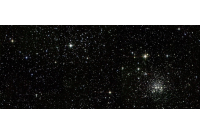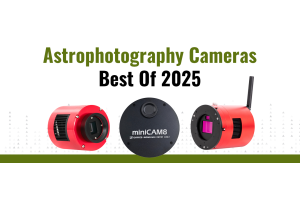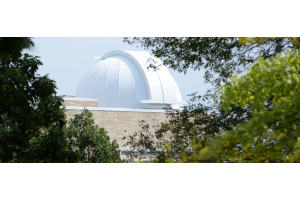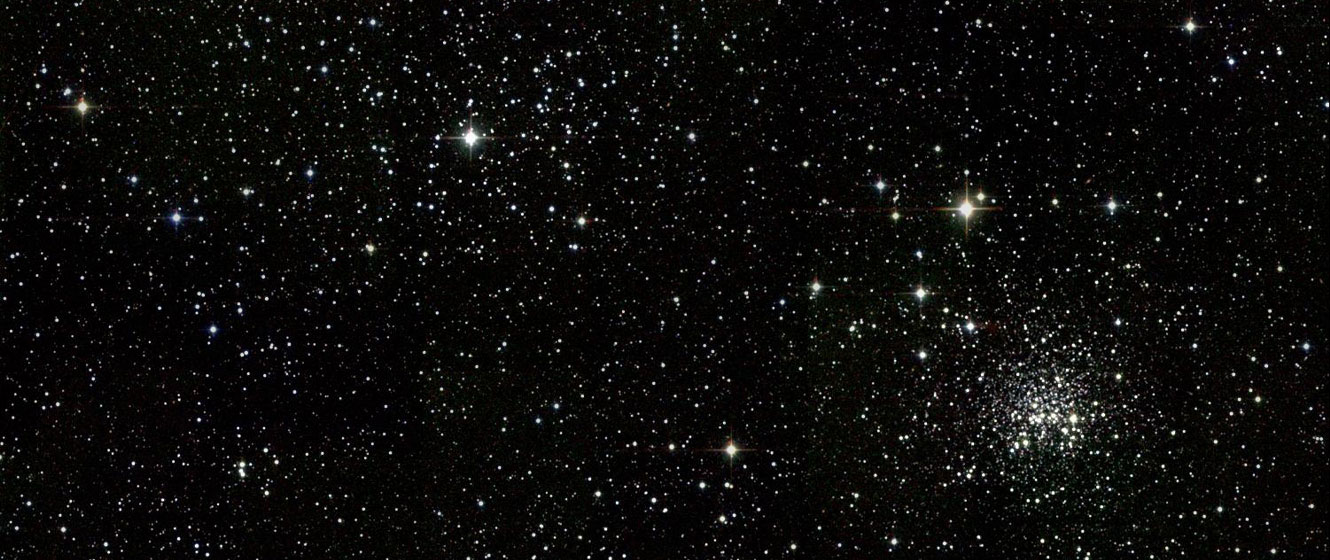
Stars are born in clusters from huge clouds of gas and dust in space called nebulae. Eventually, most of these clusters will break apart as the individual stars drift away into space. The majority of open star clusters, therefore, comprise fairly young stars, typically less than a billion years old (for comparison, the Sun is thought to be roughly 4.6 billion years old).
They’re called “open” star clusters because, unlike their cousins, the globular star clusters, open star clusters are not bound together in any particular shape or form. In fact, like nebulae, they’re often named for the creature or object they resemble. For example, M6 in Scorpius is also known as the Butterfly Cluster, whereas M38 in Auriga is sometimes known as the Starfish Cluster.
Many open clusters can be a breathtaking sight in almost any telescope of any size. That said, you’ll find that larger scopes will show more stars as larger apertures can gather more light and reveal the fainter members of the cluster. As a result, you may notice more strings and chains of stars, but the increased number of stars could also cause the cluster to lose a little of its shape.
Two Late Winter Clusters for Spring
Spring isn’t the best time for open star clusters, as there aren’t many that are bright and easily found. We can, however, cheat a little and observe two that are best seen during the mid to late winter months but can still be enjoyed before midnight in early spring.
We’ll start with Messier 35 (M35), an open cluster found at the feet of Gemini, the Twins, and close to the border with Orion and Taurus. There’s a curved line of three stars that starts with Mu Geminorum and includes Propus (Eta Geminorum) and 1 Geminorum. This line stretches southwest toward Al Nath and Zeta Tauri in Taurus, and all three stars will fit within the same binocular (or finder) field of view.
About midway between Propus and 1 Geminorum, and just a little to the northwest is M35. You’ll be able to spot it with binoculars, even under suburban skies. It appears as a relatively large group of faint stars with 10x50 binoculars, but a small telescope will reveal a lot more.
A small telescope with a magnification of around 40x will give a nice view of the cluster, with what seems to be hundreds of stars being visible. Almost all of these will appear either blue or blue-white, but look out for a gold star with a slightly fainter blue star beside it, on the edge of the cluster.
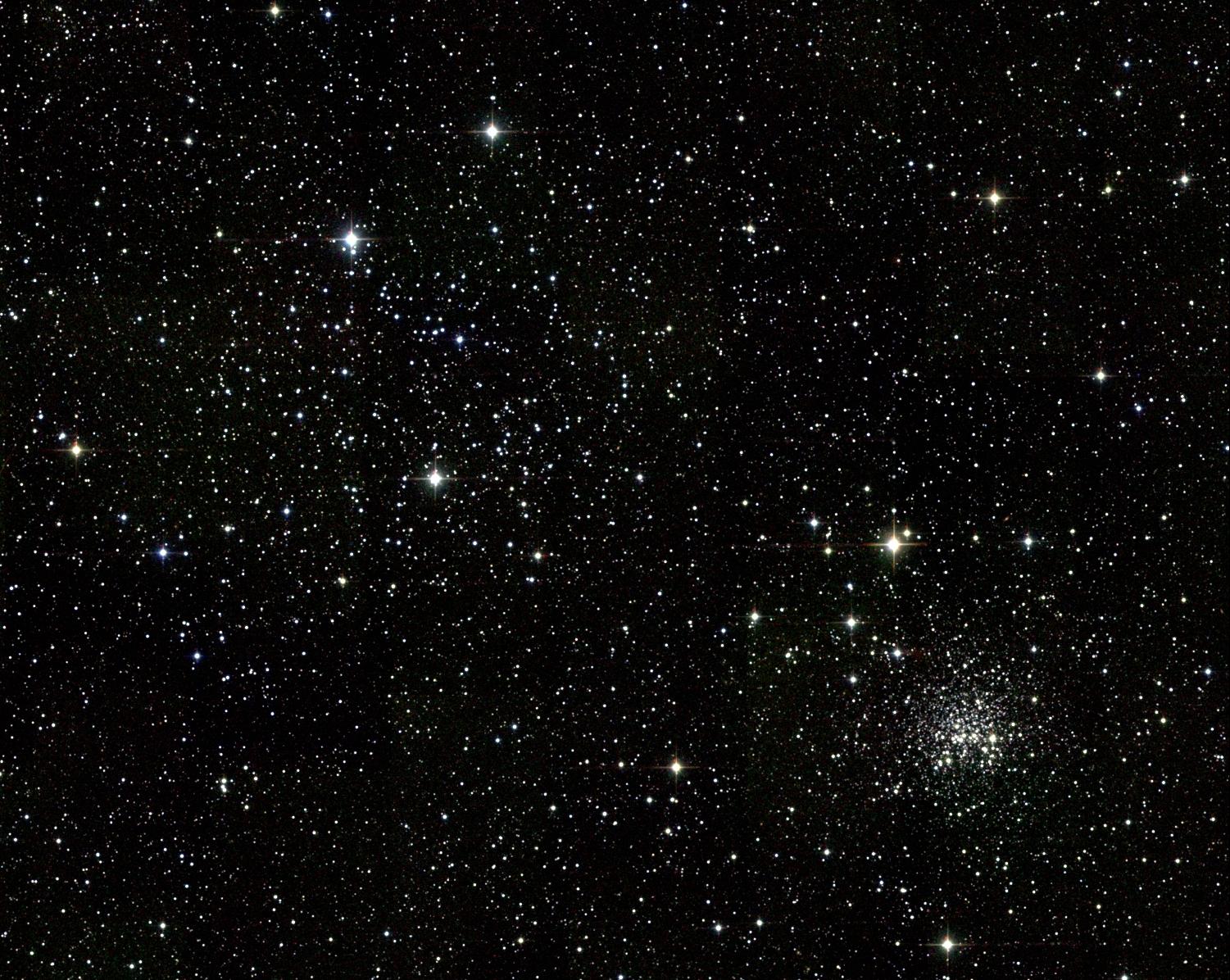
Mid-sized scopes will show more stars, with the cluster having an undefined outer edge and a dark band dividing it in two. Chains of stars can also be seen scattered throughout the cluster. Large scopes show clumps of stars scattered across the cluster, with more chains being visible near the dark band and the gold and blue pair on the cluster’s edge.
Our other spring open star cluster, the Beehive (Messier 44), can be found in neighboring Cancer the Crab. Although it’s visible to the naked eye, you’ll most likely need dark skies to spot it as it’s easily overwhelmed by light pollution. The easiest way to find it is by looking roughly midway between Castor in Gemini and Regulus in Leo, and it’s best to use binoculars to help you locate it.
The Beehive is a fairly large cluster and doesn’t require a lot of magnification. In fact, using a magnification that’s too high can actually be detrimental as the entire cluster won’t fit within the field of view.
A small telescope at about 35x will show about 50 or 60 stars of varying brightness, with the brightest forming a group that looks a little like the constellation Cepheus at the center. The vast majority of the stars are blue-white, but you’ll notice a few orange stars scattered here and there.
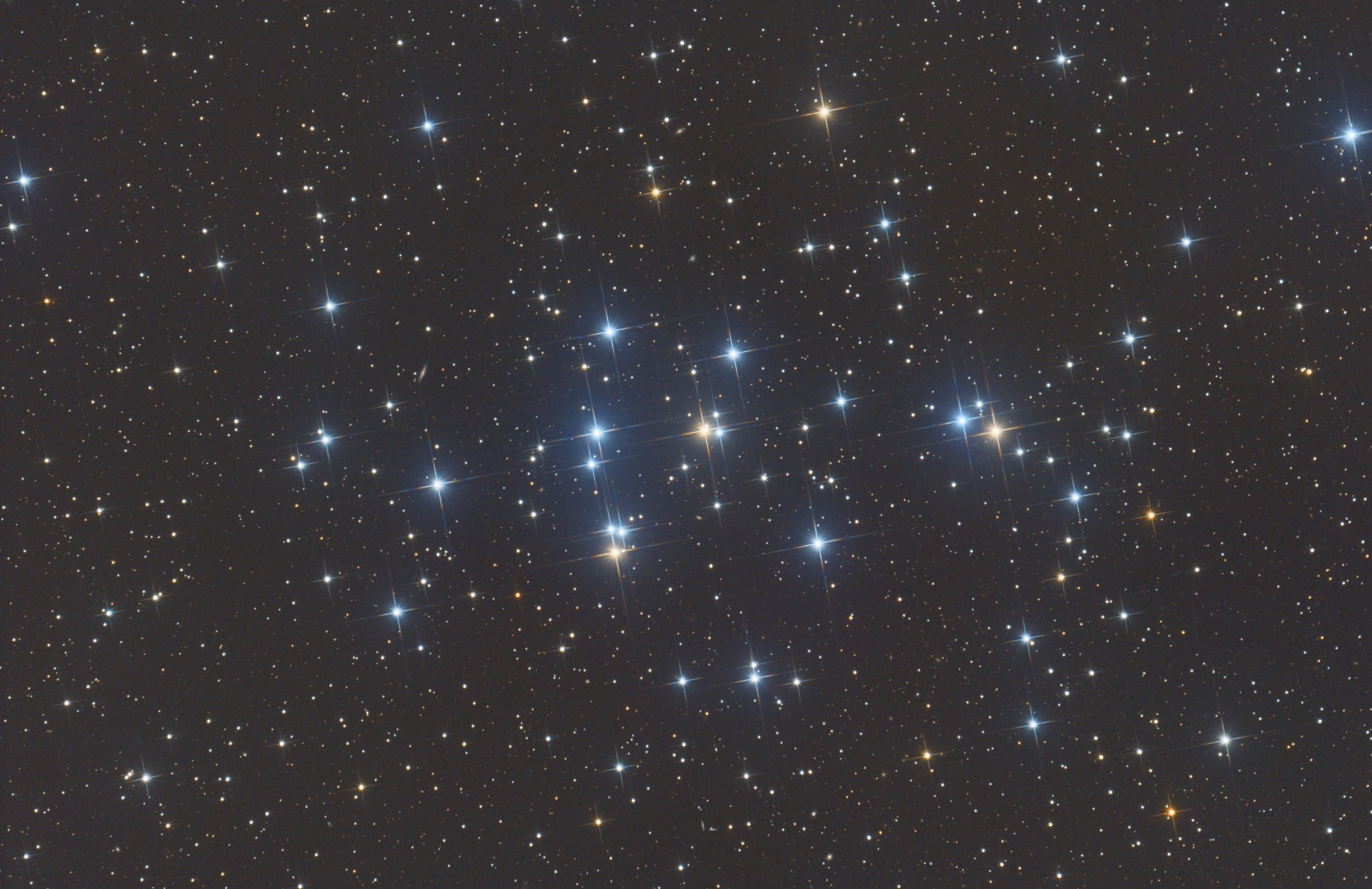
Image Credit: Fried Lauterbach
A mid-sized scope can show about 75 stars with a number of chains becoming visible and a triple star near the center. Large scopes can show close to 100 stars, but the cluster also starts to lose its shape and structure. However, you’ll see more chains, not to mention double and triple stars and some yellow stars intermingled with the others.
The Stinger Clusters of Summer
There are a number of star clusters to be seen during the summer months, but arguably none are so easily found as the Butterfly Cluster (Messier 6) and Ptolemy’s Cluster (Messier 7).
If you live under dark skies, you may be able to see them both with the naked eye, but if not, they’re easily detected with binoculars from even suburban skies. Both are located in the constellation Scorpius, the Scorpion, close to Shaula (Lambda Scorpii) and Lesath (Upsilon Scorpii). Better yet, both will easily fit within the same binocular or finderscope field of view as those two bright stars, making them super easy to locate.
Of the two, Ptolemy’s Cluster is the larger and brighter. This is another large cluster, about the same size as the Beehive, and a low-powered eyepiece is the best choice. Through a small telescope, you’ll see plenty of blue-white stars with the brightest forming the shape of a bow tie. The fainter stars are fairly sparsely scattered across the field of view. A number of pale gold stars can also be seen and there’s a double composed of one gold and one blue star at the heart of the cluster.
Through mid and large-sized scopes you’ll count about a hundred stars, the majority of which are white or blue-white, with many forming doubles or triples. You’ll also notice chains of stars stretching out from the center and an arc stretching across half the cluster’s width to the north of the core.
Its neighbor, Messier 6, is also known as the Butterfly Cluster, and for good reason. Its shape is apparent through a small telescope at low to mid magnifications (below 100x) with a magnification of around 75x providing the best view. It’s a richer and more condensed cluster than Messier 7, with countless blue-white stars of varying brightness. Its brightest appears at the lower tip of one wing with two fairly prominent curved lines of stars forming the antennae.

Image Credit: ESO
Fantastic Star Clusters for Fall
Autumn provides us with two star clusters that are both easy to find and look good through a telescope - and as an added bonus, they lie close to one another in the sky.
Our first, NGC 457, is a large, reasonably bright cluster that’s a favorite with amateur astronomers of all levels. The constellation in which it can be found, Cassiopeia the Queen, is visible throughout much of the year and appears to circle about Polaris, the Pole Star, as the months go by.
However, it’s highest during the autumn and its brightest stars can be seen forming a crooked M shape high over the northern horizon at this time. NGC 457 can be found within the same finderscope field of view as Ruchbah (Delta Cassiopeiae) and can be detected with binoculars under a dark sky.
NGC 457 goes by many names but perhaps the two most popular are the Owl Cluster and the ET Cluster. A small telescope and a low-power eyepiece are all that is needed to reveal why the cluster is known by these names.
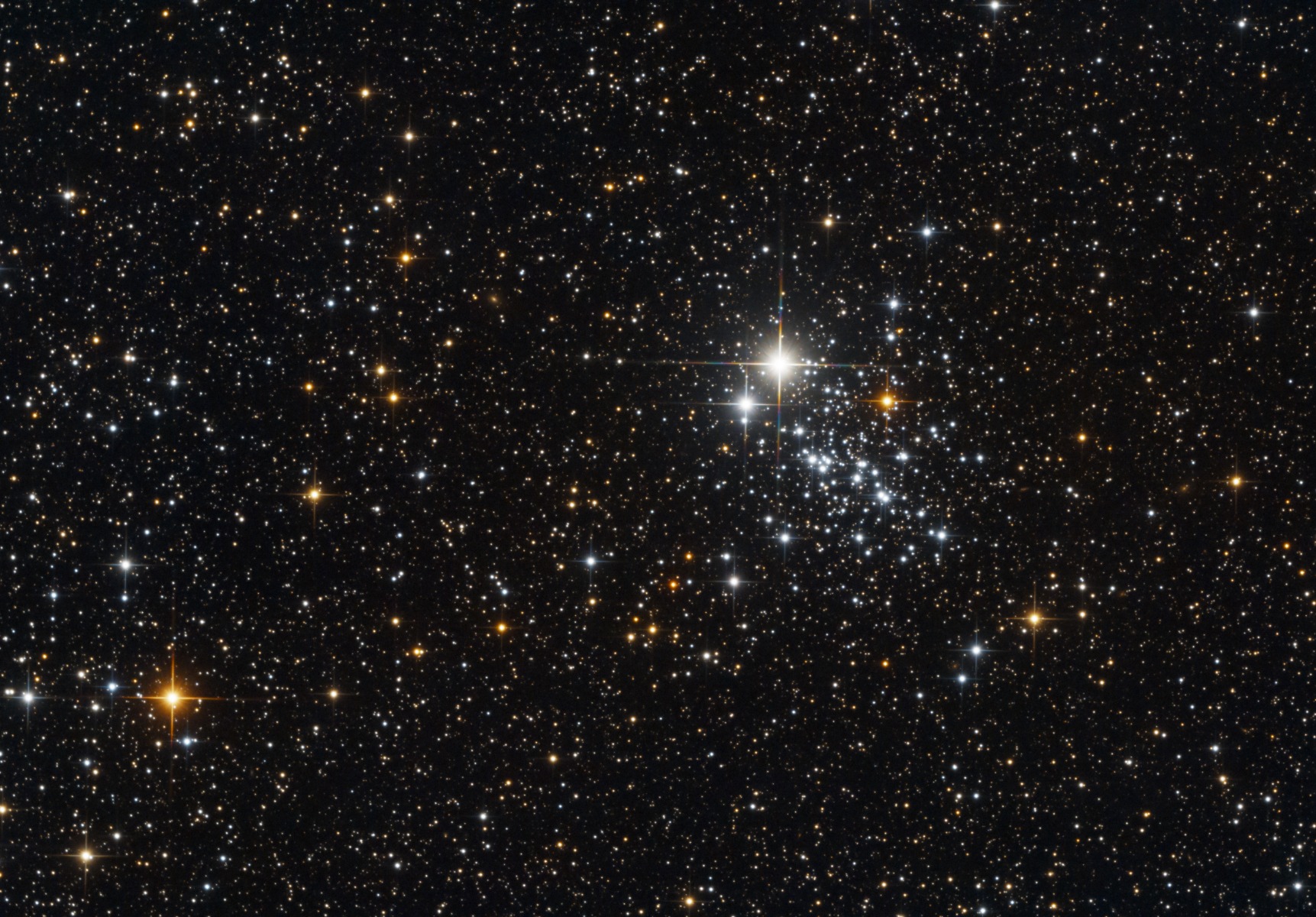
Image Credit: Marcel Nowaczyk
For starters, you’ll immediately see a pairing of two bright stars that form the eyes of the owl (or the alien, if you prefer). The brighter of the two shines with a yellow light while its fainter companion glows blue. Together these two stars share the designation Phi Cassiopeiae and they’re the two brightest stars in a multiple star system of five.
The remainder of the stars form the body and, if you’re seeing an owl, the wings of the bird or, if you’re seeing ET, his long, outstretched arms. It’s a fairly sparsely scattered cluster, with most of the stars appearing in the chest area.
NGC 457 is definitely a cluster that can withstand a little more magnification, with larger scopes producing outstanding views. A mid-sized scope will show around 40 bright stars with large scopes potentially doubling that number. Look for chains of stars snaking through the center and a red star on the cluster’s northern edge.
Bordering Cassiopeia in the sky is Perseus the Hero, and about midway between the two is the Double Cluster, a deep-sky object that’s literally two for the price of one. These clusters have been known since antiquity, and if you live under reasonably dark skies you could see them with just the naked eye.
Perhaps the easiest way to find the pair is to go back to Ruchbah in Cassiopeia and then draw a line toward Mirfak, the brightest star in Perseus. The clusters can be found almost halfway between the two.
Again, these are reasonably large clusters so you’ll only need a low magnification to enjoy them. With that in mind, unless you’re using a wide-angle eyepiece, it’s probably best to keep the magnification below 50x. Both these clusters are attractive and worth a look in their own right, but together they make for an outstanding sight.
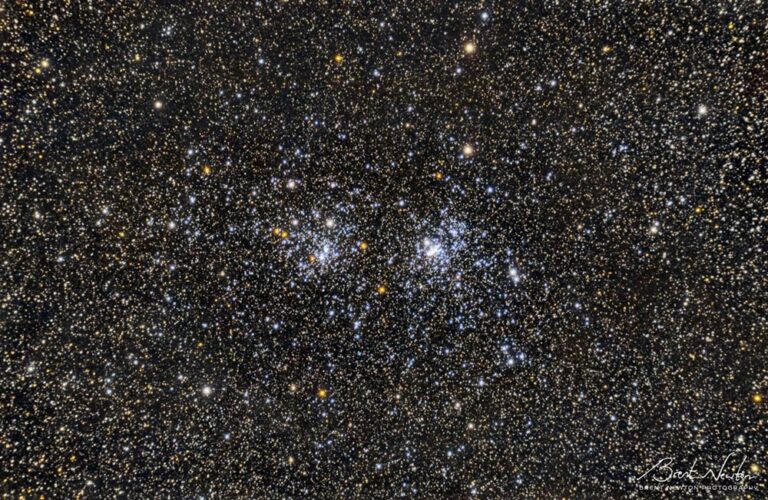
Image Credit: Brent Newton
One cluster has the catalog designation of NGC 869, while the other is NGC 884. Of the two, NGC 869 is more compact, whereas NGC 884 is more sparsely scattered. The blue-white stars are of fairly uniform brightness, but there’s a pair of brighter stars near the center of NGC 869.
Both these clusters can be spectacular through mid-sized and larger scopes. NGC 869 shows a compressed area of stars near the core with a dark lane splitting the cluster in two, while NGC 884 appears a little elongated. Larger scopes will reveal hundreds of stars in each cluster, with chains of stars reaching out from the center of NGC 869.
Two Showpiece Clusters for Winter
If you’re familiar with the constellation Orion, the Hunter, then you’ll have no problem locating the following two outstanding open star clusters for winter.
By drawing a line up through the three stars of Orion’s belt we’ll first come to coppery Aldebaran, the bright star that marks the red eye of Taurus, the Bull. Keep extending the line and you’ll come to the most famous open star cluster of all - the Pleiades.
Like the Double Cluster, this has been known for thousands of years and has been a familiar sight to many civilizations across the world and throughout the ages. As such, you can easily see the cluster with the naked eye (even from suburban skies) and it’s a fine sight through binoculars too.
As open star clusters go, this is a particularly large one, so the lower the magnification, the better. Ideally, you’ll need an eyepiece with a wide field of view and/or a magnification of around 40x or less. Increase the magnification too high and you won’t be able to see the entire cluster.
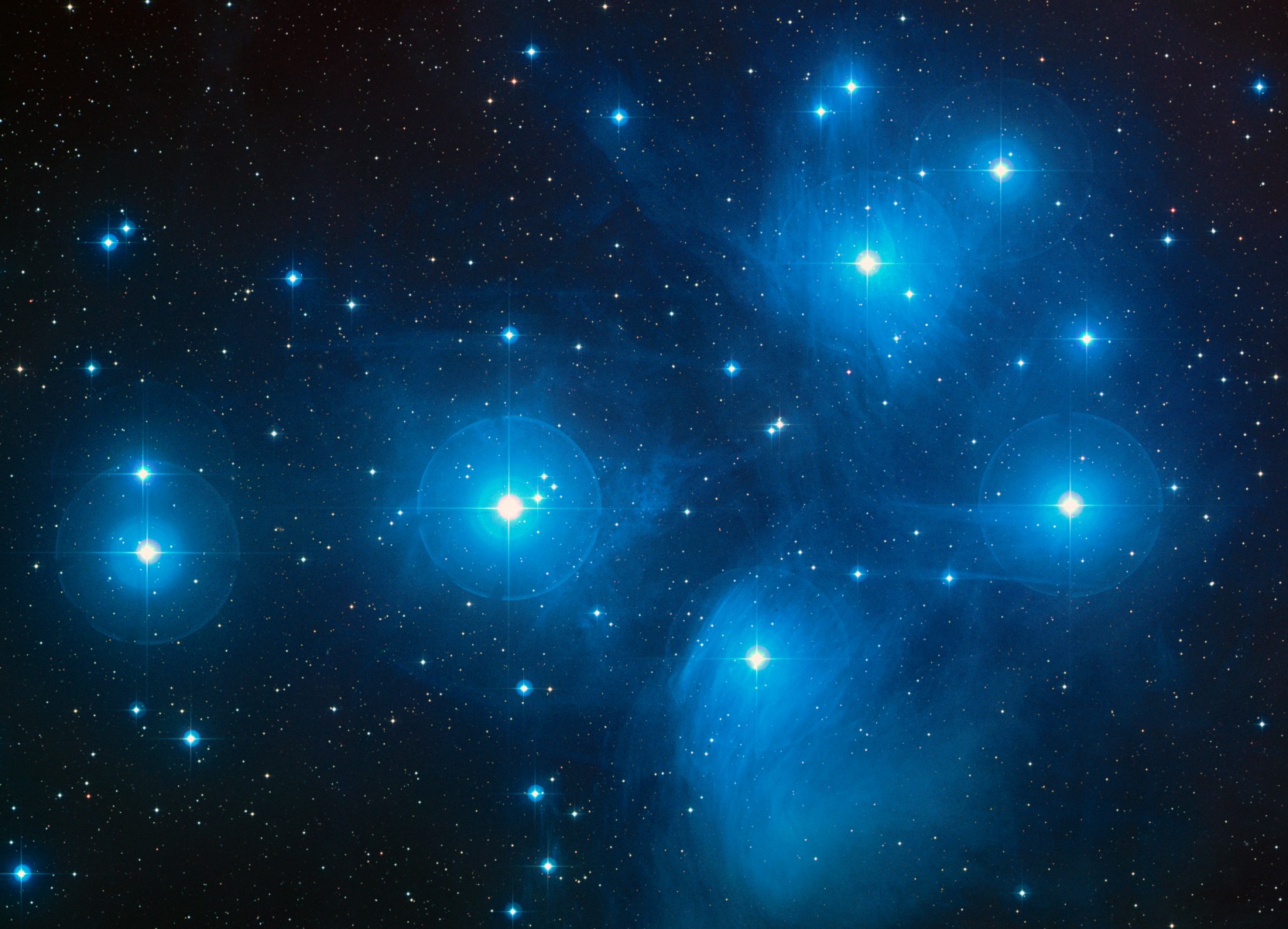
Image Credit: NASA, ESA, AURA/Caltech, Palomar Observatory
The view through any scope is breathtaking. A small scope will show a triangular formation of stars next to Alcyone and a conspicuous chain of stars (visible in binoculars) forming a slightly curved trail to the star’s south. Be sure to also look out for a nice, coppery double in the bowl of the cluster.
Mid-sized and larger scopes can show hundreds of much fainter stars, but it’s the faint nebulosity that’s the Holy Grail here. In photos, the nebula shows up as a stunning haze that appears to swamp the cluster’s stars with an ethereal blue mist. Unfortunately, our eyes aren’t as sensitive to light as the camera lens, but if you have excellent skies, you may be able to glimpse the brightest portion around Merope.
Experienced observers have seen the nebula with small scopes, but realistically, you’ll probably need to start with the largest aperture scope you can lay your hands on. Investing in a nebula filter will also help you in your search.
To end the year, we’ll finish with a star cluster that can be found by drawing a line from Orion’s belt in the opposite direction. So rather than going up toward the stars of Taurus, follow the stars down, and pretty soon you’ll come to Sirius, the brightest star in the entire night sky.
If you’re looking at Sirius when it’s over the southern horizon, then turn your telescope to the area just below it. Keep Sirius toward the top of the field of view and then look directly below it and closer to the bottom edge. You should be able to see a small, hazy patch with an irregularly shaped perimeter - this is M41, our second winter cluster.
M41 is bright enough to be seen with the naked eye, but you’ll need dark skies to see it. (You’ll probably also need to cover Sirius with your hand otherwise its light could overwhelm the considerably fainter cluster.)
The cluster is a little reminiscent of autumn’s NGC 457 (the Owl or ET Cluster) but with more stars. A low magnification will show those stars to be relatively sparsely scattered, with the vast majority being blue-white in color and many of these being of roughly the same brightness.
It’s a great target for almost any telescope, with curved chains of stars being readily apparent. Medium-sized scopes will show about 50 stars, while larger scopes will double that number and reveal a semi-circle of stars at the center.
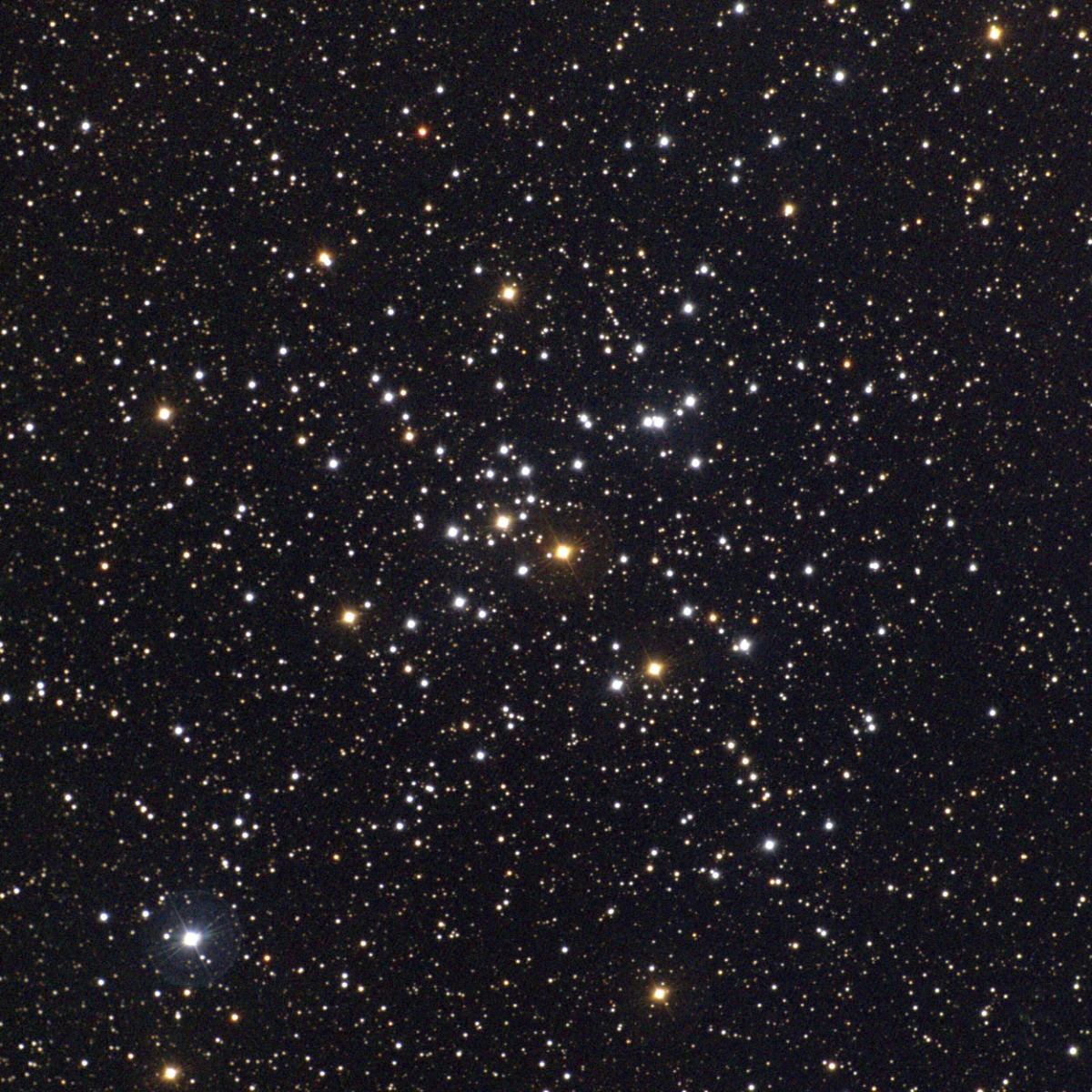
Image Credit: NOIRLab / NSF / AURA

Learn More
Interested in learning more about what's in the night sky? Not sure where to begin? Check out our Astronomy Hub!
This Article was Last Updated on 08/15/2023





